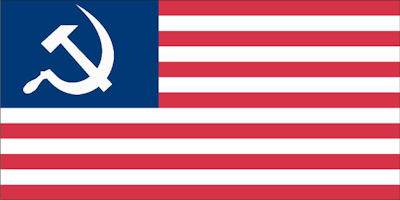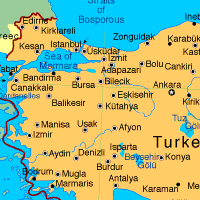![]()
Sun, Jan 15, 2012 | Rubin Reports | By Barry Rubin
Can Real Liberalism and the Democratic Party Be Saved from the Radical Takeover?
“I want the people to know that they still have 2 out of 3 branches of the government working for them, and that ain’t bad.”
— Jack Nicholson as “President Dale” in Mars Attacks.
The far left has at least temporarily won the battle of ideas in the United States and taken over institutions by pretending to be “liberal.” Meanwhile, actual traditional liberalism, which ruled those institutions for many decades, has vanished. Suddenly, we are supposed to believe that “class warfare,” anti-capitalism, hatred of America, Stalinist-style treatment of opponents, the glorification of the extremist Occupy movement, a mass media all too devoted to propaganda, and a betrayal of Enlightenment values are normative liberal ideas!
During the 1930s, the Communist Party tried to take over liberalism but failed miserably. Today, however, the post-Communist left has succeeded in that effort to a remarkable extent, effectively wiping out the memory of what liberalism was actually like. For their part, many conservatives are quite willing to reinforce the left’s rewriting of history, suggesting that Barack Obama and the destruction of once-great institutions is a natural and inevitable outgrowth of people like Franklin Roosevelt, Harry Truman, John F. Kennedy, and Lyndon Johnson.
Yet there is a sizable bloc of traditional liberals who have been repelled by the radical takeovers of institutions and the destruction of their own ideas. They have not yet found a voice but, if given proper treatment and leadership, they are about to far exceed the “Reagan Democrat” phenomenon.
According to a recent Gallup poll, 21 percent of those who considered themselves Democrats when Obama became president no longer do so. And if you add in those still calling themselves Democrats and who will vote loyally while being very disturbed with what’s happening, that number might total about half. These are people who never felt comfortable with the new radicalism, who have woken up in the last three years, or will do so very soon. That’s the constituency I want to speak to. And briefly here’s the message:
The Obama administration is a radical, not liberal, government. Its domestic policies will never get the country out of the current depression. Its foreign policy is a disaster. It is no longer 1911 or 1932 or 1945 or even 1961. The United States has dealt with the old bigotries to a remarkable extent. Environmental pollution has come under control. Conservatives have accepted these changes. Giant corporations are not controlling everything.
America doesn’t have seemingly unlimited funds to devote to achieving perfection and solving every social or environmental problem. The government may have been too small 80 years ago but now it is too big. Spending is too high and debt threatens the country’s future. Regulation is strangling business and impinging on personal liberty to a ridiculous extent. Stop demonizing conservatives. They are not a reincarnation of the Klu Klux Klan or mindless idiots.
Vote Obama and the leftists in Congress out of office. If the Democrats don’t provide you with good alternatives then vote Republican, if only to teach them a lesson and force the party back toward the center. Conservatives are far preferable to radical leftists, just as that was so during the Cold War. If a post-Obama Democratic Party moves back toward the center then you can return to it — and if not, then give up on it.
You shouldn’t have to be a conservative to be horrified by the contemporary situation. But while conservatives and Republican are going to lead the opposition to the status quo, they should seek to build a broad front rather than wage a campaign against historical liberals. This doesn’t mean they have to water down their program, but it should be presented in a way designed to broaden its appeal. The target should be the far left, and its camouflage as merely “liberal” should be exposed.
And if there is not going to be a bipartisan basis for cutting the size of government, reducing spending, rejecting the nanny state, undoing strangling regulation, and undertaking other such needed structural reforms, how will there ever be a working majority to get these things done?
A starting point is to remember what really happened in the course of U.S. history. Since the United States became urbanized and industrialized, there have been three broad positions in American politics: the left, liberalism, and conservatism.
Forget about making Theodore Roosevelt, Woodrow Wilson, and Franklin Roosevelt your villains. It’s historically untrue and plays perfectly into the left’s hands. It is more than happy to pretend to be the natural successors of such people, all the better to dupe the large part of its constituency that reveres those presidents but would be horrified to understand that it is really being fooled into following the successors of the Communists and New Left.
Consider, for example, the history of the word “progressive.” Originally, the nineteenth-century progressives were people who saw America falling under the sway of corrupt big-city political machines and massive corporations, institutions that had never existed before and against which no effective safeguards existed. Agrarian America had become industrial America.
They understood that only a stronger government and such institutions as trade unions could balance the power of the monopolies. Those progressives also understood that if they failed to rein in what was then an uncontrolled capitalism, there was a real chance of leftist revolution. A great deal was achieved and the tide of radicalism and laissez-faire capitalist domination was avoided. By the end of World War One, the movement ended because it had achieved so many of its goals.
By the 1920s, the word “progressive” was no longer used by liberal reformers and instead was taken over by the left, seeking to cloak itself in an attractive mantle and make itself seem more moderate. In 1924, two Progressive parties were organized: one Communist, the other Socialist and trade union-led. Both quickly collapsed though not before the latter received 17 percent of the vote in the election.
During the 1930s, Earl Browder and other Communist Party leaders used the word “progressive” as a cover. In 1948, it was the name chosen by the Communist Party for its “moderate” front party.
Consider how the Communist Party approached the New Deal. Here’s that party’s leader, Earl Browder, being interviewed in 1936:
“There isn’t an ounce of socialism in the Roosevelt administration. [President Franklin] Roosevelt stands for capitalism but he tries to remedy this capitalism of some of its worst abuses, hoping thereby to give it longer life.”
Roosevelt, Browder continued, was being pulled by some to the left and by others to the right. Consequently, it would be wrong for “all progressives to unite around Roosevelt as the sole means to defeat reaction.” The “progressive side” must be tough and independent to push for the policies it wants.
The reporter conducting the interview concluded, “It seems that personally Roosevelt and [Republican leader Alf] Landon look pretty much alike to Browder…but as a Communist leader he prefers Roosevelt to Landon’s supporters.”
Yes, that was the historic situation. The radical left — those who wanted to “fundamentally transform America,” in Obama’s words, and not to remedy its “worst abuses,” as Browder saw Roosevelt — hated real liberals. It merely wanted to fool them, win them over, or destroy them.
Real liberals understood this very well and derided the dupes as “fellow travelers.” During the 1940s and 1950s liberal groups were energetically anti-Communist, suspicious of an excessively big government, believed in American greatness, and supported a U.S. international role as a great power.
Remember that it was Truman who led America to recognize and fight the Soviet threat and it was his administration that successfully purged Communists from the U.S. government. And the labor unions threw out the Communists, too.
One of the main groups formed by liberals, in 1947, was the Americans for Democratic Action, an anti-Communist and anti-“Progressive” organization. The ADA’s founding document clearly struck a balance: “The interests of the U.S. are the interests of free men everywhere.” In terms of domestic policies, the ADA wanted to continue the New Deal but warned, “Civil liberties must be protected from concentrated wealth and [an] overcentralized government.”
Within two years, the left was soundly defeated. In the face of the Cold War challenge, liberals worked with the mainstream — that is, non-isolationist — conservatives in forging a bipartisan foreign policy. Meanwhile, the conservatives accepted many of the liberal domestic changes, including the New Deal’s creation of a social safety net and civil rights. The two groups, despite their disagreements, worked together effectively against those who wanted to overthrow the American system. The United States prospered at home and abroad.
And if you want to know how totally the left has triumphed today, look at the Wikipedia entry for the Americans for Democratic Action:
“Americans for Democratic Action (ADA) is an America political organization advocating progressive policies. ADA works for social and economic justice through lobbying, grassroots organizing, research and supporting progressive candidates.”
This is a 180 degree shift from its original purpose. The transformation of institutions into what the Communists called “front groups” and “transmission belts” has been stupendous. While ADA is no longer significant, the positions it holds today sound like Occupy Wall Street.
The situation today is not the descendant of normative liberalism but rather of the New Left. After its miserable failure in the 1960s (a period peaking from around 1967 to 1973), those who still believe in its dogmas “worked within the system” and ultimately utterly transformed it.
In the late 1960s, for example, former SDS President Carl Davidson came up with “new working class” theory. The cultural-psychological dissatisfactions of the professionals, not the economic grievances of the proletariat, would be the motive force for change. Over time, things like educational indoctrination, the manipulation of public debate, the staffing of the media with people of certain beliefs, and such methods would play a key role in seizing power in the commanding heights of cultural-intellectual production.
In 2008, Carl Davidson headed Progressives for Obama, the explicitly radical component in supporting Obama’s campaign. At that time, nobody else was using the word “progressive.” Now, everyone in that camp uses that label. What better symbol of the far left’s triumph?
The left may lose to conservatism at the ballot box. But its hegemony over universities, publishing, entertainment, culture, and the mass media can only be defeated by an ideological revival of moderate liberalism. Like it or not, those controlling these institutions have been too inoculated with the demonization of conservatives to be challenged by them. As in the Cold War with Communism, what’s needed is an anti-leftist liberalism that can show where the left has lied and deceived.
Today, though, I’m not aware of a single group that has risen to defend a real liberal alternative to the Obama vision or to denounce the far left worldviews and policies so damaging not only to America itself but also to academia and the media.
The key question is this:
If Obama is defeated in November 2012 and the Republicans take Congress in a landslide, would that be enough to shatter the far left’s cultural-educational hegemony and liberate the Democratic Party from its grip? Can a real opposition movement arise?
Or would the left be able to hold on, using hatred and demonization to maintain control?
And no matter what happens politically, can an anti-leftist liberal movement arise to try to take back the media, universities, and other institutions to play their proper role as open and balanced rather than serving as organs of indoctrination?



 RSS
RSS











Can Real Liberalism and the Democratic Party Be Saved from the Radical Takeover? | Middle East, Isra http://t.co/uDjNxg0y
Can Real Liberalism and the Democratic Party Be Saved from the Radical Takeover? | Middle East, Isra http://t.co/uDjNxg0y